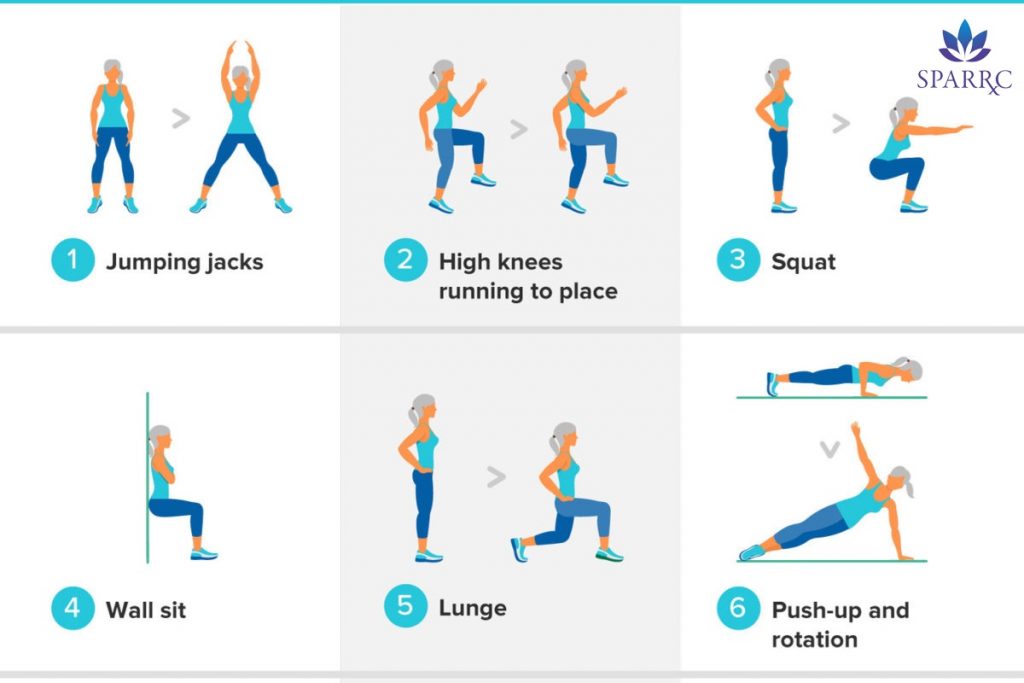High-intensity interval training (HIIT) SPARRC
HIIT is an immersive 30-minute-long series of high intensity training exercises. The length of one HIIT workout is perhaps also the length of our favorite episode on a certain OTT platform. Except, HIIT is saddled with a rich reservoir of long-term health benefits. So, in perspective of our physically taxing work schedules, it is important to invest our time wisely.
Here’s why High-Intensity Interval Training (HIIT) is a form of exercise that alternates between short intervals of rigorous anaerobic exercise with less engaging recovery periods. What makes HIIT interesting is its time saving efficiency to burn calories in a short interval. In our fast paced lives HIIT fits in seamlessly in more ways than one.
HIIT workouts usually don’t last for more than 30 minutes making them an easy fit for hectic schedules
Such workouts can burn a large amount of calories in a short amount of time both during and after the work out owing to the afterburn effect (EPOC- Excess Post- Exercise Oxygen Consumption)
Cardiovascular Health
HIIT can improve cardiovascular health by increasing VO2 max (the maximum amount of oxygen the body can utilize during exercise).
Blood Pressure and Blood Sugar
Regular HIIT can help reduce blood pressure and improve insulin sensitivity, aiding in blood sugar control.
Muscle Building and Fat Loss
HIIT is effective for getting rid of visceral fat. Visceral fat envelops the organs in our belly. It blanktes our intestines, internal organs and the length of the stomach. Although it is normal and healthy to have visceral fat but excessive visceral fat brings with it the risk of health problems like diabetes, stroke and heart disease.
Muscle Retention
HIIT can help maintain muscle mass while losing fat, which is beneficial compared to steady-state cardio. HIIT workouts usually feature movements like plyometric exercises that recruit fast twitch muscle fibres. This improves agility, power and speed.
Metabolic Rate
The intense nature of HIIT increases metabolic rate for hours after exercise, leading to more calories burned even when the body is resting.
Types of HIIT:
1. Tabata Training
– Involves 20 seconds of ultra-intense exercise followed by 10 seconds of rest, repeated for 4 minutes (8 rounds).
– This was developed by Dr. Izumi Tabata in Japan.
2. Fartlek Training
– Speed play involves alternating pace between sprints and slow jogs throughout the session.
– This is often employed by sprinters to improve speed and endurance.
3. Circuit Training
– Series of different exercises performed chronologically with limited periods of rest between them.
– This series features an array of strength training and cardio exercises.
Adaptations and Variations
1. Bodyweight HIIT
– Involves exercises like burpees, jumping jacks, and high knees, these exercises can be tailor made and are done without the help of equipment
2. Equipment-Based HIIT
– Can use kettlebells, dumbbells, battle ropes, or stationary bikes to increase intensity and variety.
3.Sports-Specific HIIT
– Customised to imitate the intensity and movements of specific sports, beneficial for athletes.
Psychological and Health Benefits
1. Mental Health
HIIT can help reduce symptoms of depression and anxiety through the release of endorphins.
May improve cognitive function and memory.
2. Health
– Regular HIIT is associated with a lower risk of metabolic syndrome, type 2 diabetes, and certain cardiovascular diseases.
Practical Tips
– Proper warm up and cooling down before and after HIIT is essential to prevent injury and aid recovery
Progression
– Start with lower intensity and gradually increase as fitness improves.
Recovery
– Incorporate rest days to allow muscles to recover and avoid overtraining.
Research and Studies:
- Research shows HIIT can be as effective, if not more, than moderate-intensity continuous training (MICT) for improving fitness and health markers.HIIT can be adapted for different fitness levels and age groups, including older adults and those with chronic conditions.


